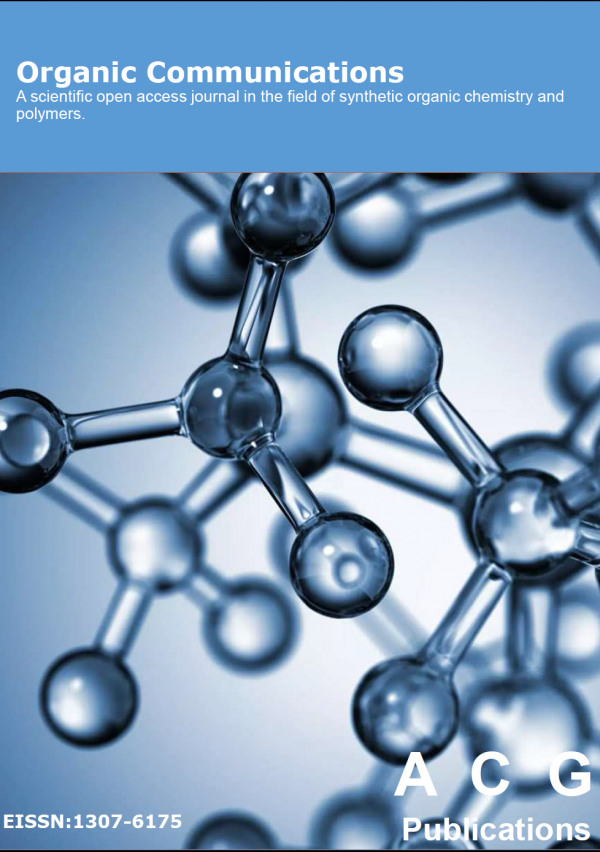Organic Communications
Year: 2015 Volume: 8 Issue:3 July-September
1) KH2PO4 as a novel catalyst for regioselective monobromination of aralkyl ketones using N-bromosuccinimide: a green methodology
A simple, regioselective and green method has been developed for the preparation of monobrominated ketones from various aralkyl ketones by using N-bromosuccinimide in presence of KH 2PO 4 in EtOH at reflux temperature. The present method is of short reaction time and simple with excellent isolated yields of products. The use of eco-friendly solvent, reuse of organic waste (succinimide) and recyclable catalyst used for 4 times without loss of activity are advantageous. This is the first example of the use of KH 2PO 4 as a useful catalyst in organohalogen chemistry and the present method meets reduce-reuse-recycle (RRR) principle towards development of green protocol.
Keywords Regioselectivity bromination ketones KH 2PO 4 Heterogeneous catalysis Green method DETAILS PDF OF ARTICLE © 2015 ACG Publications. All rights reserved.2) Synthesis and biological evaluation of 3-benzyl/piperazino- methyl-1,2,3-triazol-4-yl)-2,3-dihydro-1,3,4-thiadiazole-2-thione
A new series of 3-benzyl-1,2,3-triazol-4-yl)-2,3-dihydro-1,3,4-thiadiazole-2-thione 8(a-d) and 3- piperazinomethyl-1,2,3-triazol-4-yl)-2,3-dihydro-1,3,4-thiadiazole-2-thione 9(a-e) has been synthesized from 5-(5-methyl-1-phenyl-1H-1,2,3-triazol-4-yl)-2,3-dihydro-1,3-thiazole-2-thione 7 . Chemical structures of all the new compounds were established by IR, 1H, 13C NMR, MS and elemental data. The compounds 8(a-d) and 9(a-e) were evaluated for their antibacterial activity against human pathogenic organisms Escherichia coli, Bacillus subtilis and Staphylococcus typhi. The investigation of antibacterial screening data reveal that, compounds in the series of 8 which contain 4-chlorobenzyl, 4-nitrobenzyl moiety on the thiadiazole and compounds in series of 9 containing N-methylpiperazine moiety on the thiadiazole, displayed good antibacterial activity against all the organisms. Compounds 8c and 9a were highly active against B. subtilis and S. typhi. Most of these new compounds showed appreciable activity against test bacteria and emerged as potential molecules for further development.
Keywords Antibacterial Synthesis 1 2 3-Triazole 1 3 4-Thiadiazole-2-thione Antibacterial activity DETAILS PDF OF ARTICLE © 2015 ACG Publications. All rights reserved.3) Phthalimide containing donor-acceptor polymers for effective dispersion of single-walled carbon nanotubes
Single-walled carbon nanotubes have been dispersed by novel phthalimide containing donor-acceptor type copolymers in organic media. Brominated phthalimide comonomer has been copolymerized with several electron rich structures using Suzuki and Stille coupling reactions. Carbon nanotube dispersion capability of the resultant polymers has been assessed by exploiting the non-covalent interaction of nanotube surface with the pi-system of conjugated backbone of polymers. Four polymers have been found to be good candidates for individually dispersing nanotubes in solution. In order to identify the dispersed nanotube species, 2D excitation-emission map and Raman spectroscopy have been performed. Molecular dynamics modelling has been utilized to reveal the binding energies of dispersants with the nanotube surface and the simulation results have been compared with the experimental findings. Both experimental and theoretical results imply the presence of a complex mechanism that governs the extent of dispersion capacity and selectivity of each conjugated polymeric dispersant in solubilizing carbon nanotubes.
Keywords Phthalimide polymers carbon nanotubes separation Raman spectroscopy molecular dynamics simulations DETAILS PDF OF ARTICLE © 2015 ACG Publications. All rights reserved.